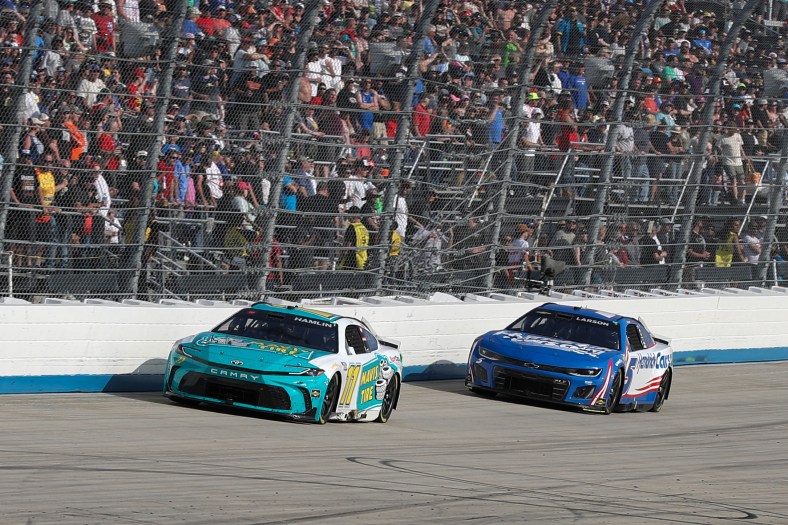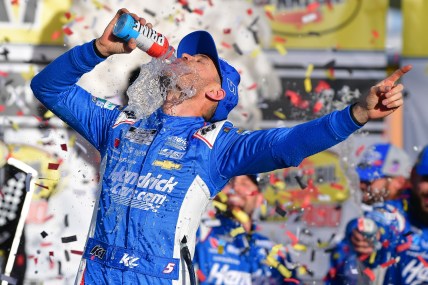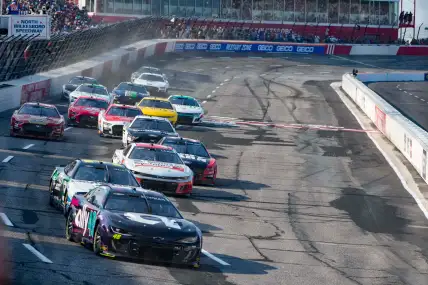
It’s a familiar refrain in the NextGen era.
The trailing driver, this time Kyle Larson caught the leader, this time Denny Hamlin, but was unable to complete the pass due to a combination of aerodynamics and air blocking tactics.
Such is how a multitude of racers are won at the NASCAR Cup Series level these days, and it certainly rang true for the Wurth 400 on Sunday at Dover Motor Speedway.
The race was effectively decided on the restart with 61 laps to go when Hamlin cleared Larson from the outside and drove away until they reached heavy lapped traffic. But the restart was also influenced by the previous restart three laps prior where Hamlin first passed a leading Larson from the bottom.
That gave Hamlin control of the race and the opportunity to take the preferred high side on the subsequent restart.
He was driving away until he reached traffic, at which point he backed up towards Larson, who himself was unable to overcome the defensive line run by the leader. Unlike the end of the first stage, where traffic gave leader William Byron fits and gave Martin Truex Jr. the opening segment victory, traffic ceded to the leaders and Hamlin was able to run his preferred lines.
Hamlin actually says he doesn’t feel comfortable racing defensively like he had to. It’s not a strength that comes natural to him.
“I think I’m probably pretty low on that list, which makes me a little worried when you’re going up against Kyle at the end of the race, someone that’s not afraid to move around the racetrack,” Hamlin said. “He’s not stuck to one line. His car was really good in the long run. He kind of reeled us in a little bit in the previous green flag run.
“I was certainly nervous, but I also knew that as long as I just did my job, hit my marks, didn’t have any major blowup laps – that’s one where it pokes how high on the graph where I missed my line or got caught in traffic – then I was going to be able to hold him off.
“He certainly made it more interesting than what I really wanted.”
But really, Larson said it wasn’t that interesting at all, and that he had no legitimate shot unless there was a significant mistake.
“He did a good job,” Larson said of Hamlin. “Like, he didn’t do anything special to win as far as the air blocking went. He executed on restarts but it’s not hard to air block in these cars.”
Larson said the wake off the leading car is so great that Hamlin didn’t even have to run the same line. He just had to cover the half of the track Larson tried to run and he stalled out each time.
He had one play and Hamlin didn’t fall for it.
“There was one time, where he started moving up, I was moving further up to move him further up and I thought maybe I could catch him off guard and shoot to the bottom,” Larson added. “I don’t know if he runs a camera but if he does, it’s really easy…
“I shot to the bottom and he immediately moved down to the bottom.”
Larson said, from experience from his victory at Las Vegas over Tyler Reddick earlier in the spring, that it’s really easy to use the on-board camera to just block whatever the trailing driver is trying to do.
He thinks the only chance a trailing driver has is removing the digital dashboard camera for a rear-view mirror like they used to have with previous generations of cars.
“It’s hard to see out of the rear-view mirrors but the cameras are so easy,” he said. “I would be for taking the camera out because it’s so easy … When I’m leading, I’m staring at my camera. When he turns right, I turn right. When he pulls down, I pull down.
“When you have the mirror, you can’t see well … but the camera is a tool and we’re all using it.”
Hamlin doesn’t think that would have changed the outcome at all.
“It wouldn’t change anything because the spotters would tell you where to drive,” Hamlin said. “I’d rather fix the car or tire or something.”
That same old conversation the industry is having each week for tracks that aren’t intermediate tracks, even though the air blocking is just as prevalent there.
Big picture, the races are decided more than ever, percentage wise on pit road and restarts. The Joe Gibbs Racing No. 11 is consistently the best on average and Hamlin ultimately won the race with the restart where he beat Larson, despite having the non-preferred bottom line.
And once a team earns that track position, the game has now changed for how the leader and trailing cars run their respective races. It was summed up best by Kyle Busch on Sunday after the race.
“The aero blocking is so bad, it’s so bad and everybody knows it and uses it as a defense item,” Busch said.
This is one day after he made the argument that the NextGen is a defensive car, where its predecessors was an offensive car.
And Hamlin executed in all the ways races are won these days.
“Honestly, we’re running a car that just hates being in traffic,” Hamlin said. “It does not like being behind another car. That’s why it races really well on tracks that are really wide because the second-place guy can go whenever the leader is not.
“It’s a cat-and-mouse game. Sometimes you start the corner here, you drive up when you see all you need to do is get him to cross your wake and you know you’re going to send his car off track.
“It’s a product of the car. It just happens at all tracks now. I think it happened five years ago when we went to the intermediate package that we went to.”
Matt Weaver is a Motorsports Insider for Sportsnaut. Follow him on Twitter.




